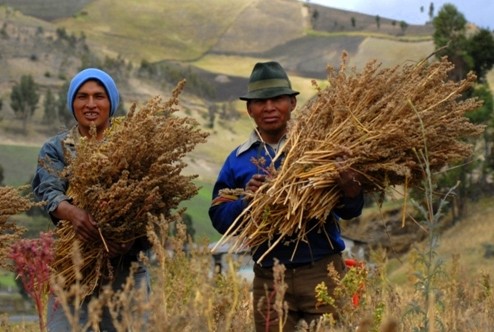Eat Quinoa To Lose Weight And Improve Your Health
By Tara Green | Nov 12, 2011

Quinoa is native to South America. The pre-Columbian Incas saw it as a sacred food, calling it chisaya mama (mother grain). They planted the first seeds of the season in religious ceremonies using golden tools. Depriving the people of quinoa was one of the means the Spanish used to conquer the Incas. In recent years, people who value nutrition have begun to appreciate the wisdom of the Incas in esteeming this food which offers a host of health benefits.
Quinoa Protein
Technically, quinoa (KEEN-wah) is classified not as a grain but as a type of seed, that of the goosewort plant, a relative of spinach and chard. Quinoa provides a complete protein, making it especially valuable for those who prefer to reduce or completely eliminate animal protein from their diets. It contains all the essential amino acids, including lysine, which is crucial for growing and repairing body tissues. One cup of quinoa provides 9 grams of protein which is one more gram than a medium chicken egg (and unlike the egg, quinoa is unlikely to come from a factory farm).
Migraine Protection
Its high magnesium and riboflavin (B2) content make quinoa an excellent nutritional ally for migraine sufferers. Magnesium prevents the migraine pattern of constricting and rebound dilating of the blood vessels. Migraine sufferers who consume more magnesium in their diets have reported fewer headaches. Riboflavin’s ability to promote cellular energy production has a beneficial effect on energy, brain and muscle cells metabolism, providing further protection against migraine attacks.
Cardiovascular Health
Magnesium’s ability to relax blood vessels also means eating foods high in this mineral helps reduce hypertension, heart arrhythmias and ischemic heart disease.
Digestion and Detoxifying
This seed-like grain has prebiotic properties, feeding the beneficial bacteria in your digestive tract. Since it is easily digested, your body can readily access the vitamins and minerals it contains. Quinoa also provides a good source of insoluble fiber, promoting healthy elimination processes, helping maintain colon health and preventing the formation of gallstones. The folate and vitamin B in quinoa also boost the liver’s ability to eliminating toxins from the body. People at high risk for cancer, as well as those with high blood pressure or cardiovascular disease are often advised to eat more whole grains, yet if they have celiac disease or other forms of gluten sensitivities, they must steer clear of many popular grain products. Quinoa is gluten-free, so those who cannot tolerate gluten can eat it.
Anti-oxidant
Quinoa also offers nearly half the daily minimum requirement for manganese and is a good source of copper and zinc. These minerals are necessary to the synthesis of the superoxide dismutase (S.O.D.) enzyme, an important antioxidant. The S.O.D. enzyme eliminates free radicals which can cause oxidation damage in the body. It not only slows the effects of aging, but may help eliminate cancer cells. Several vitamin companies offer S.O.D. supplements but quinoa enables your body to produce its own natural enzymes.
Eating Quinoa
Quinoa has a slightly crunchy and nutty flavor, a little similar to wild rice. You boil it same as rice, with a two to one proportion of water to quinoa, but with a shorter cooking time. Try substituting quinoa for rice in stuffed peppers or alongside beans and avocadoes in a vegetarian burrito. You can make a hot breakfast cereal using quinoa along with honey and dried or fresh fruits or use it in place of other grains, making a tabbouleh-like salad using quinoa, nuts, seeds and chopped vegetables with a light vinaigrette dressing. You can also add quinoa to soups. Most health food stores offer not only quinoa but flour and noodles made from the highly valued food.
Learn more: http://www.naturalnews.com/034110_quinoa_nutrition.html#ixzz1dPdSCXpl















